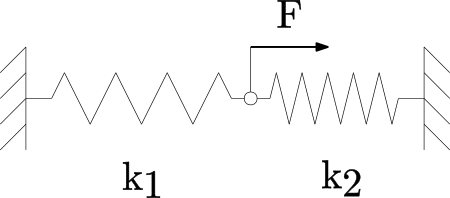Development partner for high-tech mechatronic systems! Contact Us
Series and parallel springs
Introduction
The stiffness of a system can be described and thus modeled as a combination of multiple springs arranged in series and parallel configuration.
Series configuration
Two or more springs are considered to be in series when they are connected end-to-end or point-to-point such that the force applied to one spring is transmitted to the next. When a force is applied to the system, each spring experiences the same force. However, the total deformation (compression or extension) of the series combination is a sum of their individual deformation. The combined stiffness of multiple springs in series will be lower than the individual stiffnesses.

To calculate the equivalent stiffness k_{series} of springs connected in series, you add the reciprocals of the individual spring stiffnesses k_{i} and take the reciprocal of the sum:
k_{series}=\dfrac{1}{\sum_{i=1}^{n}\dfrac{1}{k_i}}=\dfrac{1}{\dfrac{1}{k_1}+\dfrac{1}{k_2}+…+\dfrac{1}{k_n}}
Parallel configuration
In a parallel configuration, multiple springs are connected side-by-side, such that the force applied to the system is distributed among the springs. Each spring experiences a portion of the total force applied to the system, while the deformations will be equal. The combined stiffness of multiple springs in parallel will be higher than the individual stiffnesses.

To calculate the equivalent stiffness k_{parallel} of springs connected in parallel, you simply add up the individual spring stiffnesses k_{i}:
k_{parallel}=\sum_{i=1}^{n}k_i=k_1+k_2+…+k_n
Equivalent spring calculator
Tip
In some cases, it is not obvious whether the springs are in series or parallel. For instance, in the example below, it may appear that the springs are in series, but they are actually in parallel since both springs deform equally, and the force is distributed. A convenient method to determine whether the springs are in series or parallel is to assume one spring to be infinitely stiff. If the force application point doesn’t move, the system is in parallel.

